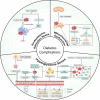Diabetes-induced male infertility: potential mechanisms and treatment options
- PMID: 38225568
- PMCID: PMC10790413
- DOI: 10.1186/s10020-023-00771-x
Diabetes-induced male infertility: potential mechanisms and treatment options
Abstract
Male infertility is a physiological phenomenon in which a man is unable to impregnate a fertile woman during a 12-month period of continuous, unprotected sexual intercourse. A growing body of clinical and epidemiological evidence indicates that the increasing incidence of male reproductive problems, especially infertility, shows a very similar trend to the incidence of diabetes within the same age range. In addition, a large number of previous in vivo and in vitro experiments have also suggested that the complex pathophysiological changes caused by diabetes may induce male infertility in multiple aspects, including hypothalamic-pituitary-gonadal axis dysfunction, spermatogenesis and maturation disorders, testicular interstitial cell damage erectile dysfunction. Based on the above related mechanisms, a large number of studies have focused on the potential therapeutic association between diabetes progression and infertility in patients with diabetes and infertility, providing important clues for the treatment of this population. In this paper, we summarized the research results of the effects of diabetes on male reproductive function in recent 5 years, elaborated the potential pathophysiological mechanisms of male infertility induced by diabetes, and reviewed and prospected the therapeutic measures.
Keywords: Chronic inflammation; Diabetes; Endocrine disorders; Hyperglycemia; Male infertility; Oxidative stress; Sperm.
© 2023. The Author(s).
Conflict of interest statement
The authors declare no conflicts of interest.
Figures


Similar articles
-
Diabetes and the impairment of reproductive function: possible role of mitochondria and reactive oxygen species.Curr Diabetes Rev. 2008 Feb;4(1):46-54. doi: 10.2174/157339908783502398. Curr Diabetes Rev. 2008. PMID: 18220695 Review.
-
Using Stem Cells to Treat Diabetes-Induced Infertility.Curr Diabetes Rev. 2023;19(7):e031122210620. doi: 10.2174/1573399819666221103143710. Curr Diabetes Rev. 2023. PMID: 36330635 Review.
-
Diabetes mellitus induced impairment of male reproductive functions: a review.Curr Diabetes Rev. 2014 May;10(3):147-57. doi: 10.2174/1573399810666140606111745. Curr Diabetes Rev. 2014. PMID: 24919656 Review.
-
Male infertility.Best Pract Res Clin Obstet Gynaecol. 2003 Apr;17(2):211-29. doi: 10.1016/s1521-6934(02)00147-5. Best Pract Res Clin Obstet Gynaecol. 2003. PMID: 12758096 Review.
-
The hidden impact of diabetes on male sexual dysfunction and fertility.Hum Fertil (Camb). 2003 Nov;6(4):174-9. doi: 10.1080/1464770312331369453. Hum Fertil (Camb). 2003. PMID: 14614196 Review.
Cited by
-
Combined Zinc and Metformin Attenuated Impairment of Corpus Cavernosum Function, Imbalance of Zinc Homeostasis, Apoptosis, and Fibrosis in STZ-Induced Diabetic Mice by Inhibiting the TGF-β1/Smad3 Pathway.Biol Trace Elem Res. 2025 Jun 25. doi: 10.1007/s12011-025-04699-7. Online ahead of print. Biol Trace Elem Res. 2025. PMID: 40563054
-
Type 1 diabetes impairs the activity of rat testicular somatic and germ cells through NRF2/NLRP3 pathway-mediated oxidative stress.Front Endocrinol (Lausanne). 2024 May 16;15:1399256. doi: 10.3389/fendo.2024.1399256. eCollection 2024. Front Endocrinol (Lausanne). 2024. PMID: 38818504 Free PMC article.
-
Testicular immunity.Mol Aspects Med. 2024 Dec;100:101323. doi: 10.1016/j.mam.2024.101323. Epub 2024 Nov 25. Mol Aspects Med. 2024. PMID: 39591799 Review.
-
GLP-1 receptor agonists show no detrimental effect on sperm quality in mouse models and cell lines.Endocrine. 2025 Aug;89(2):614-626. doi: 10.1007/s12020-025-04245-4. Epub 2025 May 10. Endocrine. 2025. PMID: 40347306 Free PMC article.
-
Regulatory mechanism of ghrelin on testosterone secretion in type 1 diabetic rats.Reprod Fertil. 2025 Jul 21;6(3):e240087. doi: 10.1530/RAF-24-0087. Print 2025 Jul 1. Reprod Fertil. 2025. PMID: 40601674 Free PMC article.
References
Publication types
MeSH terms
Grants and funding
LinkOut - more resources
Full Text Sources
Medical

